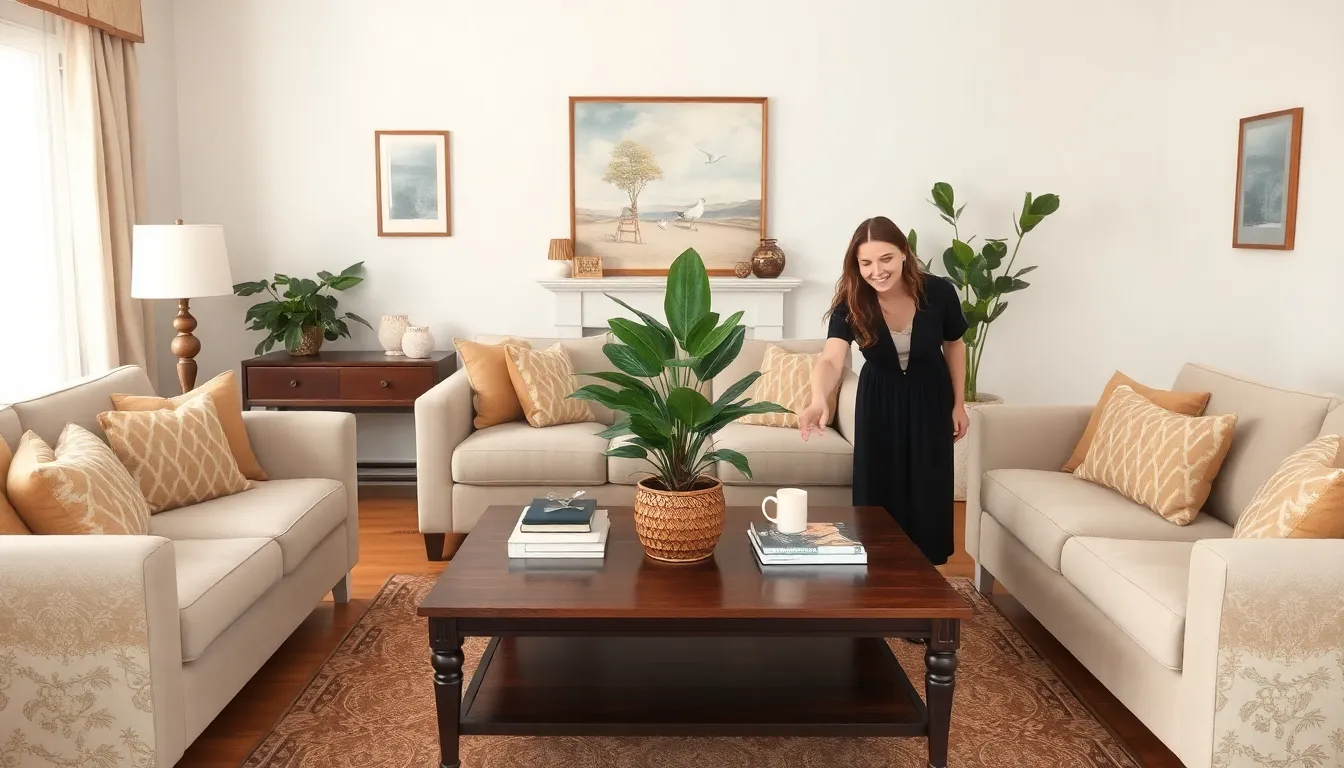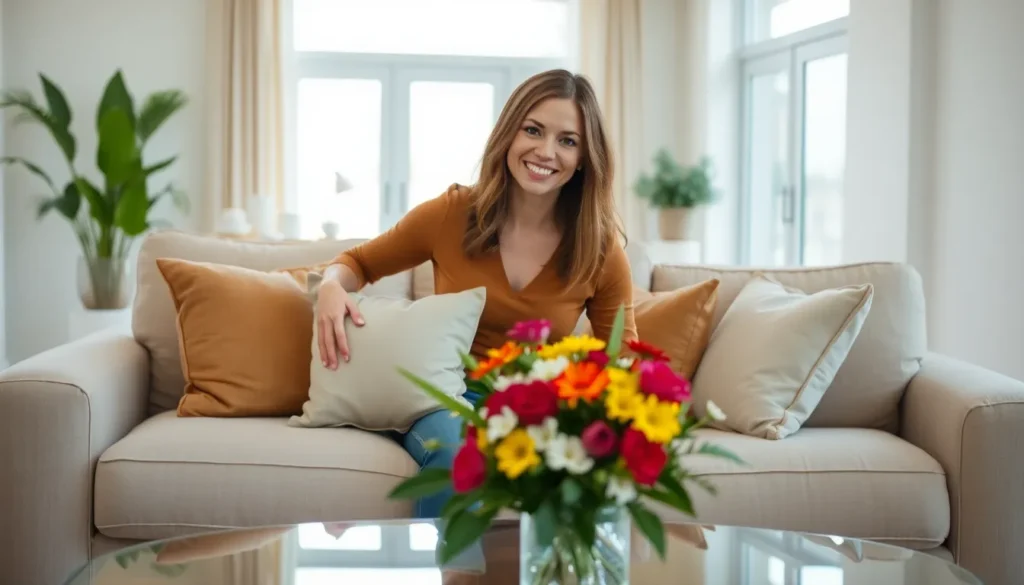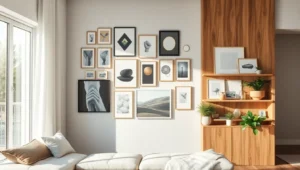Selling a home can feel like preparing for a first date—nervous energy, high stakes, and the desperate need to impress. Just like you wouldn’t show up in sweatpants, staging your home is all about putting its best foot forward. With the right home staging tips, buyers won’t just visit; they’ll fall head over heels.
Table of Contents
ToggleImportance Of Home Staging
Home staging significantly impacts a property’s marketability. It enables sellers to showcase their homes in the best light, making them more inviting to potential buyers. An appealing home can lead to quicker sales, as well-presented spaces often generate stronger interest.
Enhancing the home’s aesthetics plays a key role in attracting buyers. Buyers form opinions within seconds, making first impressions crucial. Staged homes often display more space, which can make properties seem larger and more organized.
Statistics highlight the benefits of home staging. According to the National Association of Realtors, 83% of buyers’ agents believe that staging helps buyers visualize a home’s potential. Staged homes can sell for up to 20% more than their unstaged counterparts.
Setting the right atmosphere can also evoke emotional connections. Creating a cozy, welcoming environment allows buyers to imagine themselves living in the space. Buyers are more likely to make offers when they feel a personal connection to the home.
Curb appeal is equally important when staging a home. The exterior is the first thing buyers see, making it essential to maintain a well-kept landscape. Simple improvements like fresh paint, clean walkways, and vibrant flowers can significantly enhance exterior appeal.
Investing in home staging often leads to higher offers and shorter time on the market. Properties that are staged tend to leave a lasting impression. Staging serves not only as a selling point but as a crucial strategy in a competitive real estate market.
Essential Home Staging Tips

Staging a home effectively plays a key role in impressing potential buyers. Utilizing the following tips can enhance marketability and attract higher offers.
Declutter And Depersonalize
Decluttering simplifies spaces, making them feel larger and more inviting. Remove personal items, such as family photos, to help buyers envision themselves in the home. Limit decorative items to essential pieces that create a serene atmosphere. Organizing closets and storage areas also demonstrates the home’s ample space. The goal is to create a neutral backdrop, allowing buyers to imagine their own style within the home’s environment.
Optimize Furniture Arrangement
Arranging furniture thoughtfully can improve flow and functionality. Position sofas and chairs to encourage conversation and movement throughout the rooms. Use area rugs to define spaces and create zones, especially in open layouts. Ensure each room has purpose; a guest room should look inviting, while an office should appear functional. Consider reducing the amount of furniture to avoid overcrowding, as this can highlight the home’s size and potential.
Enhance Curb Appeal
Curb appeal sets the first impression and can significantly impact buyer interest. Maintaining a well-manicured lawn and trimming bushes cultivates an inviting appearance. Adding fresh mulch and colorful flowers can brighten up the space and draw attention. Ensure the front door is clean and inviting, possibly adding a new coat of paint for a fresh look. Small details, like updated house numbers and outdoor lighting, also contribute to a welcoming exterior.
Color And Lighting Considerations
Colors and lighting significantly influence a buyer’s perception of a home. Selecting the right color palette enhances the overall aesthetic and creates mood.
Choosing The Right Color Palette
Neutral colors tend to appeal to a broader audience. Soft whites, grays, and beiges provide a clean backdrop. Accent colors, such as muted blues or greens, can add depth to each room. Coordination between spaces creates a cohesive flow throughout the home, making it feel more inviting. Popular trends like earth tones resonate with potential buyers, promoting warmth. Using paint strategically can highlight architectural features and make rooms appear larger.
Utilizing Natural And Artificial Light
Maximizing natural light brightens up spaces, making them more inviting. Sheer window treatments allow daylight to filter without sacrificing privacy. It’s essential to focus on well-placed mirrors; they reflect light and create the illusion of space. Artificial lighting enhances areas lacking windows, offering warmth and brightness. Layering lighting types, such as ambient, task, and accent, provides functionality and enhances visual interest. Using soft white bulbs creates a cozy atmosphere ideal for home staging.
Staging Specific Areas
Effective staging of specific areas enhances a home’s appeal. Each zone demands attention to detail, creating an inviting atmosphere for potential buyers.
Living Room Staging Ideas
Arranging furniture for optimal flow attracts interest. Position sofas and chairs to encourage conversation and create a welcoming vibe. Incorporate neutral-colored throw pillows and blankets to add comfort. Art pieces and decorative items should enhance, not clutter, the space. Incorporate plants for a touch of freshness and warmth. Balanced lighting contributes to a cozy ambiance; mix floor lamps and table lamps for layered light.
Kitchen And Dining Space Tips
Showcasing the kitchen as a functional hub requires careful selection. Declutter countertops to highlight available space and storage. Place a bowl of fresh fruit or a vase of flowers on the table to create an inviting centerpiece. Consider updated hardware and fixtures, as these minor upgrades elevate the room’s appeal. Keep colors light and bright, enhancing the warmth and energy. Set the dining table attractively, complete with clean dishes and simple decor, to showcase its potential for memorable gatherings.
Bedroom Staging Techniques
Creating a serene retreat is crucial for bedrooms. Use soft bedding and throw pillows to develop an inviting space. Position beds against the wall for a focal point while ensuring pathways remain clear. Personal items should be minimized, allowing potential buyers to envision their personal touch. Incorporate warm, ambient lighting through bedside lamps for a relaxing atmosphere. Organizing closet space offers buyers insight into storage potential, while freshly laundered linens add a touch of luxury.
Common Mistakes To Avoid
Avoiding common pitfalls during home staging can significantly affect marketability. Overstuffing spaces with furniture can make rooms feel cramped and uninviting. Neglecting to declutter often leads to distractions, preventing potential buyers from focusing on the home’s features. Remember that removing personal items allows buyers to envision themselves in the space.
When selecting colors, using overly bold or eclectic palettes can alienate some buyers. Sticking to neutral tones provides a clean backdrop, enhancing the appeal of each room. Insufficient lighting also detracts from a home’s ambiance. Ensuring adequate light levels, both natural and artificial, contributes to a welcoming atmosphere.
Failing to keep the exterior well-maintained can create a poor first impression. Landscaping, including simple tasks like mowing the lawn or adding planters, greatly influences curb appeal. Ignoring the front door’s appearance can also hinder interest. An inviting front door sets the tone for the entire home.
Marketing the home without professional photography may result in missed opportunities. High-quality images effectively showcase a home’s best features, attracting more potential buyers. Lastly, skipping the open house or ignoring virtual tours can limit exposure. Engaging potential buyers through these events fosters connections and creates interest in the property.
By steering clear of these errors, sellers can optimize their home staging efforts, ensuring that property appeals to a broader audience and receives higher offers. Correctly executing staging strategies contributes to quicker sales in a competitive market, capitalizing on the benefits of an attractive presentation.
Effective home staging can transform a property into a buyer’s dream. By creating an inviting atmosphere and showcasing the home’s potential, sellers can significantly enhance marketability. Simple steps like decluttering and optimizing furniture arrangements make a difference in how buyers perceive the space.
Investing time in staging not only leads to quicker sales but can also result in higher offers. With the right strategies in place, sellers are better positioned to stand out in a competitive market. By focusing on details like color and lighting, they can create a lasting impression that resonates with potential buyers. Home staging is more than just decoration; it’s a strategic approach to selling that pays off in the long run.





